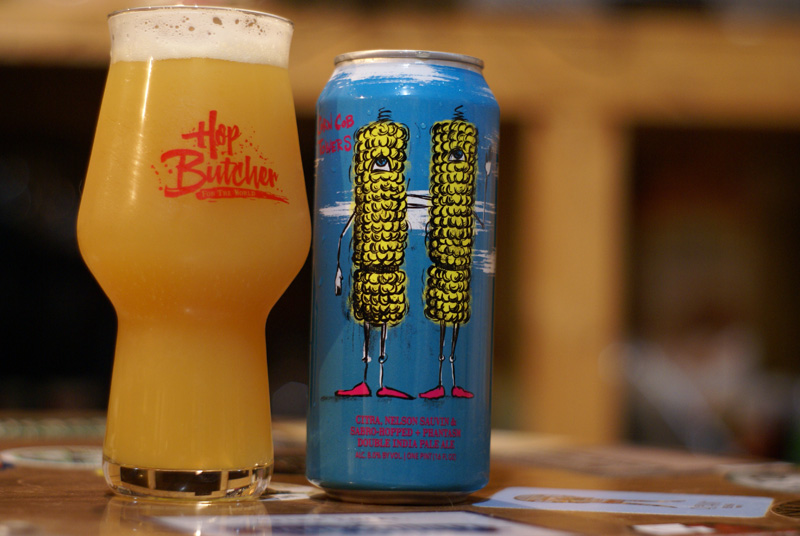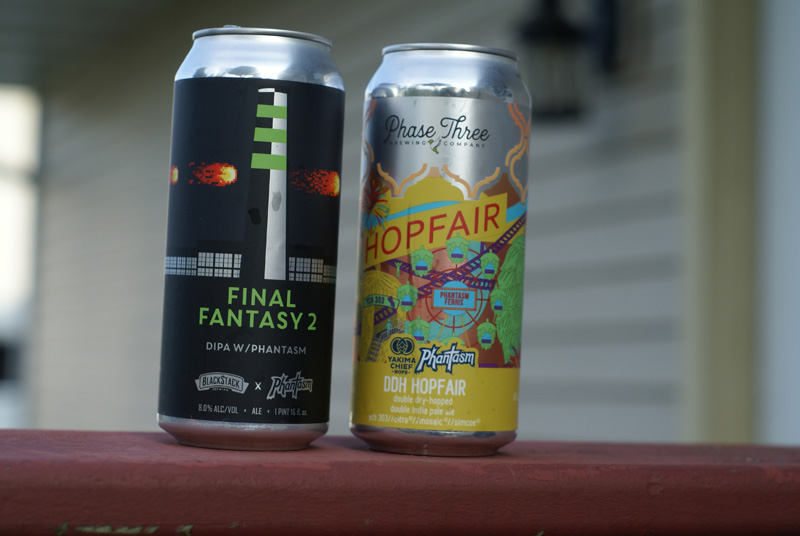Ask a brewer about hop aroma and you will receive a passionate explanation of the melon, citrus, pine, orange zest, bubble gum, and other smells that hops can exude. Bring up Phantasm Powder, a product derived from thiolozed grape skins, specifically from Sauvignon Blanc grapes from New Zealand’s Marlborough region, and brewers light up just as much.
Insight head brewer Sean Carnahan says there are “a million different flavors of the month” when it comes to brewing products, but he thought this one might do something cool.
“So using Phantasm for the first time, day two of fermentation, there were aromas in the beer that I have never smelled before in my life,” he says. After brewing for 10 years, Carnahan couldn’t believe what he was smelling: “Just unbelievably heavy tropics. Like fresh squeezed mango juice, white grape. It almost smelled like an extract. It was so unbelievably strong.”
Insight canned and released the appropriately named Phantasmic, a double dry-hopped New England IPA made with an array of hops and Phantasm, and currently has another hazy IPA with it exclusively on tap called Switch the Engines On. They’re currently waiting on a fourth beer with Phantasm that is a collaboration with Fair State to finish fermenting.
A number of other breweries in Minnesota including Little Thistle, Pryes, Elm Creek, and BlackStack have all used Phantasm. Others in the Midwest who’ve used it include Phase Three and Hop Butcher For The World in Illinois and 608 in Wisconsin.
COLLABORATING TO LEARN
Little Thistle’s co-owner and brewer Steve Finnie made Dank Wolf with Lift Bridge and plans on using his powder stash for another collaboration. Over and over the brewers who have used it have mentioned a lot of collaborations as a way to all experiment and learn with a product that has only been around for two years.
“Basically, it’s all about the thiols and the quest for the holy aromatics,” says Finnie.
These thiols are important. Taking a step back, New Zealand’s Jos Ruffell, founder of popular brewery Garage Project, developed what is now known as Phantasm and founded company Phantasm.NZ.
The organic compounds known as thiols, which contain sulfur, are found in things like hops. These thiols can create disgusting food smells like rotting eggs, or they can produce aromatics like the aforementioned mango juice. Passion fruit is another big one, and a flavor that the grapes and wine using them are known for.
So, as Finnie explains, certain hops have thiol properties or precursors that can lead them to these amazing aromatics. And from what was reported in Pursuit of Hoppiness, New Zealand hops have a lot of these precursors.
“And the goal is to unlock these aromatics – certain new bio engineered yeasts can help unlock these properties [Finnie is talking about Omega thiols, which is an entire other science lesson], as can Phantasm,” Finnie said.
Ruffell knew about thiols, the wine world, and New Zealand hops. So he began exploring ways to use discarded Sauvignon Blanc grape pomace, exploring the connection to beer. And a magic powder made from wine waste was born.
And according to every brewer we chatted with, it really, really works.
FRUITY PHANTASM
Finnie said the first beer he made with it was a hazy pale ale with Cascade hops, Calypso hops, and Berkeley Tropics yeast. This yeast is important as it’s a type of yeast that turns those precursors mentioned before into the aromatic and flavorful thiols. Finnie didn’t need to dry hop it and was able to produce passion fruit and guava.
Passion fruit comes up a lot when talking about Phantasm.
“It creates a very passion fruit aromatic kind of flavor,” Pryes Brewery founder and head brewer Jeremy Pryes plainly seconded when explaining its merits.
Hop Butcher for the World co-founder Jude La Rose has been brewing with the powder in Chicago as well, especially in beers with Citra, Simcoe, or Nelson Sauvin.
“We’ll double batch into our fermenters and between turns or batches we’ll add the Phantasm,” Rose explained. “The beer has been fermenting for 24 hours more or less and this way of incorporating it allows us to capture Phantasm’s thiol freeing potential from the start.
“We prefer the character of our regular hop volumes combined with Phantasm,” he continued. “There’s a structure and familiar character that hop pellets provide to the beer. We’ve tasted some far out beers that dial back on the hop pellet addition to allow the thiol character of the Phantasm and other thiol freeing products to really be front and center and shine. They’re unlike anything you’ve smelled before. Really far out.”
608’s co-owner and head brewer Phil Humphrey has used it in IPAs and a sour – which is not something that happens a lot – making it very wine-like in that it contains a very pronounced, deep, rich fruit flavor. Humphrey has really explored the powder in different beer styles. In addition to the sour he made a collaboration beer with Milwaukee’s Explorium two weeks ago that is a New Zealand pilsner.
“We like it; it’s awesome,” Humphrey said. “It’s so unique. I just wish more people in the market understood it and knew what it did, versus adding fruits or hops to the beer.” He’s used it with Omega’s Cosmic Punch and Heliogazer yeasts, both created to biotransform compounds in malt and hops to provide the thiol aromas and flavors.
BlackStack co-founder and director of creative and product development Murphy Johnson has used Phantasm powder in a handful of IPAs. The St. Paul brewery’s collaboration with Colorado’s Weldwerks used Phantasm powder and the Berkley Tropics Yeast specifically for releasing the thiols. Murphy was such an early adopter that he said the Alcohol and Tobacco Tax and Trade Bureau would send labels back because it didn’t know what Phantasm was.
It didn’t stop them from pushing it out.
“I love any new toy that we get to play with,” Murphy said. “I’m always open to it.”
THE PRICE OF NEWNESS
Humphrey actually forgot about Phantasm until he saw an Instagram post from the company. He had to buy three boxes for $4,000, the minimum order.
That price can be a huge barrier. Especially since so many brewers are relying on collabs to try and figure out the product together.
To put it into perspective, if a brewery is brewing a 15- or 20-barrel batch of beer, it will most likely cost $200-$300 of Phantasm powder. Barrel Theory, for example, opened with a 10-barrel brewery. BlackStack has a 20-barrel brewing system.
If you’re looking for a huge hoppy beer with trendy hops like Galaxy or Citra Cryo, you’re probably spending about the same amount on hops. It can all add up and increase the cost of four-packs.
Pryes continually muses back and forth on price, benefits, and how it’s another tool in the tool belt for brewers.
“Is it gonna change everything?,” Pryes said. “No. Is it gonna add another tool to our tool belts to be able to create, you know, an experience? A flavor experience? The answer is yes, totally. But it’s expensive.”
Humphrey says although it’s expensive – he spent $34 per pound on the powder, while others noted $40 – it could be a big deal, especially with breweries trying to pack in more fruit and juice flavors into IPAs. Humphrey can’t get enough of it and will keep using it, especially when a beer smells and tastes like you “dumped fruit in it.”
“I just hope it catches on with the crowd,” Humphrey said. “Because it is expensive. It kind of pushes the price of your beer up a little bit. And if you’re not getting the bump in sales from people getting to drink something rather unique. This isn’t something that any brewery in the country or world is doing right now. There’s only a handful of places getting to work with this awesome product.”
Carnahan thinks like all trends, including the hazy IPA, Phantasm powder might be a fad that turns into something more.
“I do not think it’s gonna be the fix; the one thing that makes your IPAs fantastic” he says. “But I do think that it could be an ingredient that people use as one of many ingredients for years to come because it definitely does offer something super unique. I do think that people would continue using it if the price points can support it.”
THE PHANTASM BEERS WE’VE HAD
I’ve had several beers with Phantasm so far, and they’ve run quite the flavor gamut.
BlackStack’s array of hoppy beers
Out of all of these breweries, BlackStack has seemed to push out the most with Phantasm. Its Final Fantasy series always uses Phantasm. The first release had a strong grape must flavor with subtle tangerine, whereas the second release, Final Fantasy: 2, was much more vibrant. The intense fruits – leaning tropical – were there in lieu of any grape must. The point of the series is to really explore Phantasm, and this should be one to watch. The other IPAs have all had vibrant hoppy fruit flavors, though some seem like they could be done with just hops. If there is a flavor deviation with Phantasm, it’s probably a bit more subtle. I expect that to change as the brewery continues to play with it.
Phase Three’s hoppiness
So far, Phase Three and Hop Butcher are leading the charge with Phantasm, which makes sense – both are making some of the Midwest’s best IPAs.
Phase Three’s DDH Hopfair used an unnamed Yakima Chief hop, ych 303, Citra, Mosaic, and Simcoe along with Phantasm for a complex array of fruit flavors that felt like eating a tray of blueberries, strawberries, grapes, and tangerines. It was done very well.

Hop Butcher’s Corn Cob Towers
The Chicagoland brewery has made some of my favorite recent IPAs for quite some time, so it’s no surprise its Citra, Nelson Sauvin, Sabro, and Phantasm double IPA has been the purest form of what’s been described in the story on the powder. The aroma and even flavor is gushing with passion fruit, but also stinky (a good thing), fresh guava, and New Zealand feijoa. It’s nearly too much, like a stinky guava, but it reels back just enough to let you enjoy the fruit burst. I love this beer and its use of Phantasm powder.
608 goes beyond IPA
608 has used the powder in the BetaBurst hazy pale ale, which was passion fruit forward in the aroma, but also used it in a fruited sour, Rype Ghostberry, and a pilsner. While I haven’t had the pilsner, the fruit beer with blackberries and aronia berries actually had far stronger fruit flavors: dark cherry, strawberry, and Welch’s grape juice all came into play. It was really fascinating as I expected the blackberry to dominate. I can’t imagine the Phantasm didn’t make a power play here and really transform this beer with more complex fruit flavors. After so many IPAs with Phantasm, I really want to see more beers like Rype.

